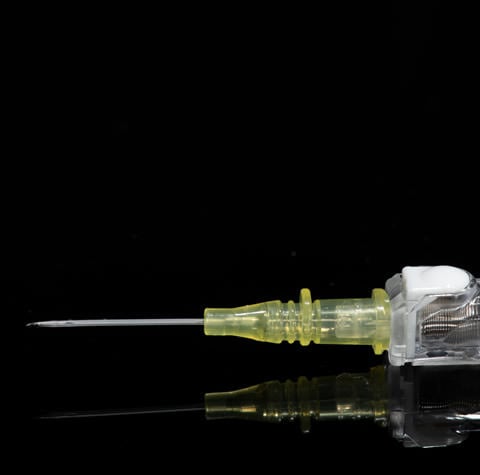Nurses are taught that critical care patients (gunshots to the chest or abdomen, car wrecks, etc.) need two large-bore IV catheters. This is a fact, but not all patients coming to the emergency department are critical care patients. What about someone who has poor venous access such as the elderly, cancer patients, or IV drug users that just need pain medications, some fluid, or IV antibiotics before discharge?
Selecting the right IV catheter for your patient helps not only the patient but also the nurse. Imagine the discomfort of being stuck multiple times and still not having IV access. The time the nurse has spent attempting to get a large-bore IV was wasted and has put the nurse behind in their other duties, not to mention aggravating the patient and the patient's family.
How To determine Correct IV Catheter Size:
It's a combination of...
-
patient assessment
-
medications ordered
-
admission status
IV catheter size determination begins with understanding the IV catheter flow rate of each gauge. The catheter packaging will specify the maximum flow rate for that specific catheter. Flow rate times 60 minutes determines how much volume a catheter can safely infuse in one hour.
What will surprise most nurses is that the lowly 24G catheter can fill almost all your infusion needs. Surprising? Let's calculate how much fluid a 24G can infuse in one hour.
A 24G's flow rate is 20 ml/min. Take that flow rate and multiply it by 60 minutes and you get 1200 ml/hour. Yes, that is correct! A 24G can infuse 1200 ml of fluid per hour. Most pumps limit out at 999 ml per hour.
With that much flow rate, you may not have to attempt a 22G, 20G, or 18G for a patient. A 24G is perfect for antibiotic or fluid infusions. Not to mention, the patient is satisfied because they only got stuck one time with the "baby" needle.
Can you draw blood through a 24G? You absolutely can. You might need a 3ml syringe to easily pull the blood, but a good 24G catheter will draw all the blood you need. I am not saying all patients have veins that will allow a 24G to draw blood. That is not true at all, but most do if the IV is good.
Here are a few situations where a 24G catheter really shines but is not usually thought about.
Ischemic Stroke
One specific situation where a 24G truly is an unsung hero is an ischemic stroke that requires rTPA but you can't get a large-bore IV on the patient. Every minute counts with a stroke patient requiring rTPA. If you delay giving rTPA because you are trying for a large-bore catheter, your patient is losing brain tissue. Although not optimal, you can give rTPA through a 24G. The maximum flow rate for giving rTPA is 81 ml/hr. This flow rate is well within a 24G's capacity. Lore has it that you cannot attempt further IV insertions on an rTPA recipient after giving rTPA. This is a guideline that should be followed as closely as you can, but you can attempt a better IV once rTPA is administered given a doctor's order. Don't waste time that causes a person to be permanently disabled because you were attempting to get large-bore IV access when small-bore access will do.
Super Ventricular Tachycardia (SVT)
One solution for SVT is administering adenosine rapidly. Granted, in this case, a large-bore IV is optimal-preferably placed in the antecubital. But you can administer adenosine via a 24G if that is all the access you can get. By far, it is not optimal, but you can do it.
IV Drug Users
IV drug users' veins are notoriously difficult to cannulate. The medications they need for pain, fluid, or antibiotics can all be given via a 24G IV. Yes, a 22G or larger is better if they are going to be admitted, but if you can only get a 24G, administer the medications first and obtain an order for PICC or midline access second.
Elderly Patients
Elderly patients' vein walls are fragile. Attempting a larger bore IV on these patients is almost always a recipe for disaster. Not all, but most have poor veins. First, you do not want to cause the patient any undue pain or anxiety. Second, the family is in the room, and they are watching you "torturing" their loved one. Granted, we all know you are not torturing the patient, but to a layperson, it might seem that way. It is also a perfect complaint opportunity to be lodged against you with your board of nursing.
What is the solution to these difficult IV situations?
Ultrasound-guided IVs. Learn to use the ultrasound machine for difficult IV cannulations and your problems with obtaining IV access nearly go away. Refer to your hospital's policy on placing ultrasound-guided IVs.
Now, a 24G IV catheter is not a panacea for all your IV cannulation needs, but it covers many situations that most nurses do not think about. A 22G is probably the best for patients being admitted to the hospital with poor venous access. A 20G allows you to give an adult patient blood, while an 18G allows you to fluid resuscitate a patient quickly. No one IV catheter fits all patient requirements, but the lowly 24G shouldn't be ignored.



LML131, RN
4 Posts
~WORD ?